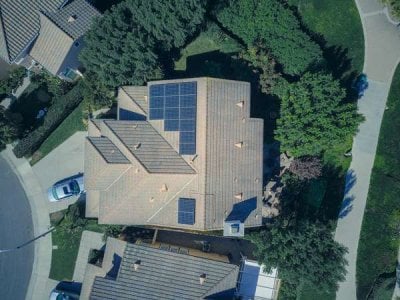Will this proposal cut your energy bills dramatically? See the government's plans for solar batteries
By
Danielle F.
- Replies 19
As the cost of living continues to rise, Australians feel the pinch with every bill.
However, there could be a glimmer of hope on the horizon for those weary of the relentless surge in energy costs.
Prime Minister Anthony Albanese recently made a bold pledge that could see homeowners and small businesses breathe a sigh of relief when it comes to their power bills.
Prime Minister Albanese promised a 30 per cent cut in solar battery costs should his government be re-elected.
This initiative was part of the Labor government's Cheaper Home Batteries Program that could roll out starting 1 July 2025.
The program could be a win for individual households, small businesses and community facilities across the country.
According to the Department of Energy's modelling, households equipped with rooftop solar could see an annual reduction of up to $1,100 on their power bills.

Homeowners who have been considering the installation of both a battery and solar system may see savings of up to $2,300 annually.
This figure represented 90 per cent of an average family's electricity bill—a significant slice of the cost of living pie that the Labor government has been keen to address.
'Delivering cost of living relief is Labor's number one priority,' Prime Minister Albanese stated.
'We want to ensure Australians have access to cheaper, cleaner energy. This is good for power bills and good for the environment.'
'Only Labor has a plan to build Australia's future,' he concluded.
Energy Minister Chris Bowen echoed this sentiment and highlighted the program's potential to allow more homes and businesses to store solar energy for use anytime.
'The contrast is clear—a re-elected Albanese government will take pressure off household energy bills, while Peter Dutton's Liberals will spend $600 billion on a nuclear plan that drives power bills up,' Energy Minister Bowen stated.
Under the Cheaper Home Batteries Program, homeowners could see up to a $4,000 reduction in the upfront cost of installing an 11.5kWh virtual power plant-ready battery.
This discount could decrease over time in line with projected battery cost reductions.
It should be delivered through the existing Small-scale Renewable Energy Scheme—effective since 2011.
The government's vision is that the increased uptake of batteries should not only benefit those who install them.
It could also contribute to lower energy prices across the board by reducing overall demand on the grid.
With an additional one million batteries projected to be installed by 2030, the ripple effect could be significant.
Despite the optimism surrounding the policy, Opposition Leader Peter Dutton criticised the plan.
'Mr Albanese is promising higher electricity prices at this election, his admission today that he's going to have to compensate people with batteries because his power prices will go up in the next term of government,' Dutton stated.
'I just think people will see through it.'
St Vincent de Paul's National Director of Energy, Gavin Dufty, warned that the government should be careful when designing the battery subsidy policy.
Should the design be pulled off well, Aussies may benefit from the program.
John Grimes, the Chief Executive of the Smart Energy Council, called it 'the most important development in consumer energy since Australians first gained access to subsidised solar panels'.
Meanwhile, Property Council Chief Executive Mike Zorbas emphasised the importance of electrification as the fastest and cheapest way to decarbonise the built environment.
As the election looms closer, the promise of slashed solar battery costs could be a deciding factor for many Australians eager to take control of their energy bills.

What are your thoughts on Prime Minister Albanese's solar battery plan? Would it influence your vote in the coming polls? Share your opinions with us in the comments below!
However, there could be a glimmer of hope on the horizon for those weary of the relentless surge in energy costs.
Prime Minister Anthony Albanese recently made a bold pledge that could see homeowners and small businesses breathe a sigh of relief when it comes to their power bills.
Prime Minister Albanese promised a 30 per cent cut in solar battery costs should his government be re-elected.
This initiative was part of the Labor government's Cheaper Home Batteries Program that could roll out starting 1 July 2025.
The program could be a win for individual households, small businesses and community facilities across the country.
According to the Department of Energy's modelling, households equipped with rooftop solar could see an annual reduction of up to $1,100 on their power bills.

Homes who have yet to install solar batteries may benefit from the proposed Cheaper Home Batteries Program. Image Credit: Pexels/Kindel Media
Homeowners who have been considering the installation of both a battery and solar system may see savings of up to $2,300 annually.
This figure represented 90 per cent of an average family's electricity bill—a significant slice of the cost of living pie that the Labor government has been keen to address.
'Delivering cost of living relief is Labor's number one priority,' Prime Minister Albanese stated.
'We want to ensure Australians have access to cheaper, cleaner energy. This is good for power bills and good for the environment.'
'Only Labor has a plan to build Australia's future,' he concluded.
Energy Minister Chris Bowen echoed this sentiment and highlighted the program's potential to allow more homes and businesses to store solar energy for use anytime.
'The contrast is clear—a re-elected Albanese government will take pressure off household energy bills, while Peter Dutton's Liberals will spend $600 billion on a nuclear plan that drives power bills up,' Energy Minister Bowen stated.
Under the Cheaper Home Batteries Program, homeowners could see up to a $4,000 reduction in the upfront cost of installing an 11.5kWh virtual power plant-ready battery.
This discount could decrease over time in line with projected battery cost reductions.
It should be delivered through the existing Small-scale Renewable Energy Scheme—effective since 2011.
The government's vision is that the increased uptake of batteries should not only benefit those who install them.
It could also contribute to lower energy prices across the board by reducing overall demand on the grid.
With an additional one million batteries projected to be installed by 2030, the ripple effect could be significant.
Despite the optimism surrounding the policy, Opposition Leader Peter Dutton criticised the plan.
'Mr Albanese is promising higher electricity prices at this election, his admission today that he's going to have to compensate people with batteries because his power prices will go up in the next term of government,' Dutton stated.
'I just think people will see through it.'
St Vincent de Paul's National Director of Energy, Gavin Dufty, warned that the government should be careful when designing the battery subsidy policy.
Should the design be pulled off well, Aussies may benefit from the program.
John Grimes, the Chief Executive of the Smart Energy Council, called it 'the most important development in consumer energy since Australians first gained access to subsidised solar panels'.
Meanwhile, Property Council Chief Executive Mike Zorbas emphasised the importance of electrification as the fastest and cheapest way to decarbonise the built environment.
As the election looms closer, the promise of slashed solar battery costs could be a deciding factor for many Australians eager to take control of their energy bills.
Key Takeaways
- Prime Minister Anthony Albanese made an election pledge to cut the cost of solar batteries by 30 per cent.
- The Cheaper Home Batteries Program is set to commence on 1 July 2025 and is aimed at households, small businesses, and community facilities.
- Energy Minister Chris Bowen contrasted the Labor Party's renewable energy focus with Opposition Leader Peter Dutton's nuclear plans.
- Experts shared their differing views and opinions about the proposal and how it could benefit Australians.







